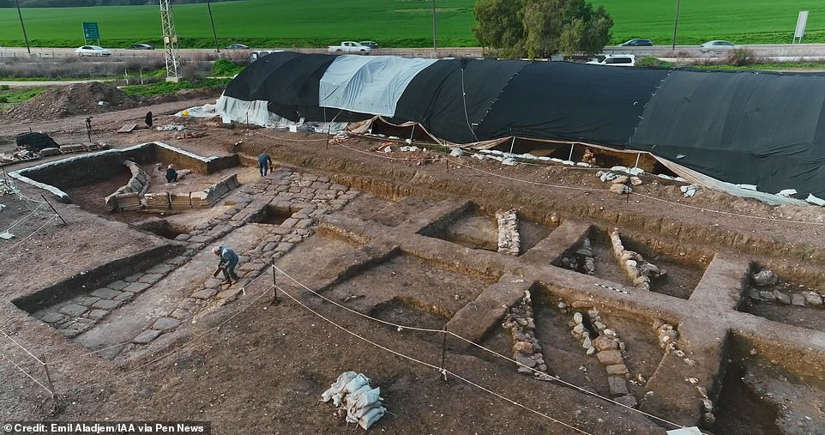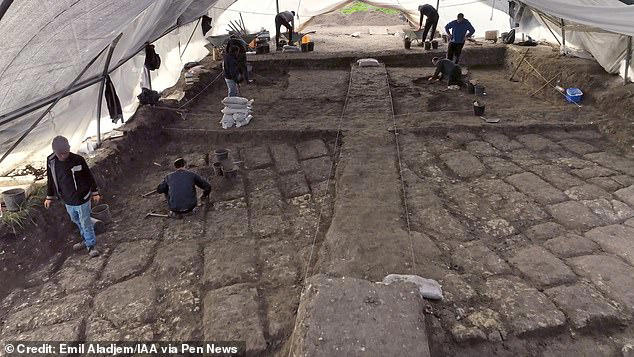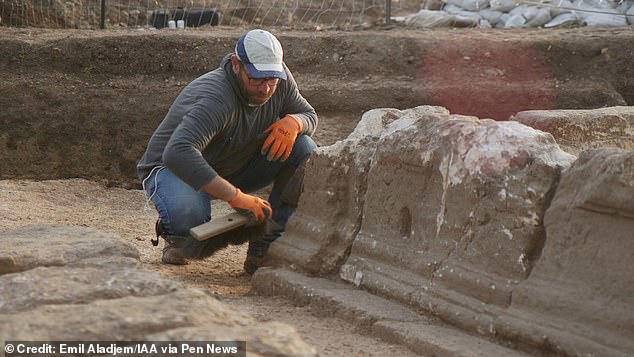-
Posts
2,366 -
Joined
-
Last visited
-
Days Won
135
Content Type
Profiles
Forums
Static Pages
News
Blogs
Gallery
Events
Downloads
Posts posted by guy
-
-
A possible example of a proto-Basque language has been found in Northern Spain on a bronze good-luck charm shaped as a hand. It is thought to be from the Vascones, considered the ancestors of modern Basques, and it would have been placed onto the entrance of a building.
The Vascones were able to negotiate with the Romans when the Romans first arrived in Spain. The Vascones were a fierce and independent tribe who were known for their martial skills. They were never fully subdued by the Romans and were able to maintain some degree of autonomy by paying a tribute to Rome.
The Vascones raised at least one auxiliary cohort in support of the Roman army, Cohors II Vasconum. Galba rose up against the Nero in AD 68, possibly with support of this cohort.

https://es.m.wikipedia.org/wiki/Cohors_II_Vasconum
-
-
On October 2023, an Ancient Roman tomb was found during water work in the city of Giugliano, near Naples. On the wall was a fresco of Cerberus, the mythical three-headed dog who guarded the underworld.
-
Here’s an interesting article on painting projects in Ancient Rome:
QuoteA cautionary house-painting tale is shared by the first-century B.C. author Vitruvius, who tells of the folly of Faberius, one of Julius Caesar’s scribes. Faberius had a taste for red and, to paint his colonnaded courtyard on Rome’s Aventine Hill, he went for the more expensive option—cinnabar—over cheaper red ocher. “Faberius would likely have been a freed slave, so this would have been a case of the sort of conspicuous consumption that Pliny the Elder would later deplore,” Becker says. Vitruvius warns that using cinnabar in open spaces where it will be exposed to sunlight or moonlight destroys the color—which is exactly what happened in Faberius’ courtyard. His prized peristyle turned black after just 30 days, “on which account he was obliged to agree with the contractors to lay on other colors,” writes Vitruvius.
Working with chemists including Ruth Beeston of Davidson College and Greg Smith from the Indianapolis Museum of Art at Newfields, Becker is currently analyzing pigments found in the shop to identify their composition. This might, in turn, help reveal where they came from. “There isn’t any evidence of manufacturing in the shop,” Becker says, “so I’m assuming the pigments were processed elsewhere.”
https://www.archaeology.org/issues/544-2403/digs/12134-dd-italy-roman-painting
-
The city of Winchester, England (about 60 miles or 10o km Southwest of London) is better known for its medieval history. The city, however, was formally the important Roman town of Venta Belgarum (the market of the Belgae).
A new book further examines previous archaeological finds on the city:
QuoteThis name was a Romanisation of the Brittonic word for market, Uenta, and the name of the tribe that lived in the area, the Belgae. It essentially meant ‘market of the Belgae’.
Roman army surveyors likely undertook the laying of streets, and creation of a system of defences, and historians suggest this may have taken place around the first century AD, just a few decades after the Romans invaded.
The city had a system of baths showing that many of the people had a Romanised way of life. Evidence points to there having been an aqueduct up to 24 kilometres long, although no ruins of it have been found.
Historians believe the people of Roman Winchester would’ve flourished, with building materials brought in from Bath, food delicacies from the Mediterranean and wine from the Rhineland. Roman style houses with mosaic floors and central heating were built in the centre of the city.
-

(Picture from Dr J Ball @DrJEBall): Suspected snack remnants (fruit seeds, stones, and pits) found during recent archaeological studies from the drainage system at the Colosseum
There has been a previous post about evidence of snacks at the Colosseum found at archaeological excavations in the drainage system of the Colosseum. (See post below.) This is another wonderful video by Max Miller: “Eating at the Colosseum.”
-
A silver brooch depicting the she-wolf suckling the twins Romulus and Remus has been found in Villanova d’Alcolea, Spain. It dates to the second century AD and measures about 4 cm (1.6 inches). It was found during an excavation of a suspected ancient Roman site.
Background on Romulus and Remus mythology:
-
More images of the excavation:
-

Artifacts, including jewelry and coins, have been uncovered in Roman tombs near the village of Nova Varbovka in Bulgaria. A bronze medalllion of Caracalla minted in Pergamon in AD 214 has also been recovered. These finds date from the early third century AD.
Interestingly, one of the tombs was a child’s tomb that contained gold earrings, glass bead jewelry, and two glass lacrimatory bottles (or tear catchers). (See photo below)
A lacrymatory (from the Latin lacrima meaning tear) is a small vessel found in Roman tombs. These were supposedly the bottles in which mourners dropped their tears. More likely, these vessels contained perfumes, fragrances, or unguents for the corpse.

https://archaeologymag.com/2024/02/medallion-of-emperor-caracalla-found-in-bulgaria/
A previous discovery of lacrymatory bottles:
-
5 hours ago, Georgelew said:
How would the construction of a solar farm near Roman Richborough impact the archaeological site and its historical significance, and what measures can be taken to ensure the preservation of both the environment and the ancient ruins?
That is the question Mary Beard and others are asking. Solar farms take up many acres and can be unsightly. They would permanently alter the local landscape and irreparably damage any historical site.
-

Recent excavations at Megiddo, Israel have discovered evidence of Legio VI Ferrata (Iron) Legion (see post below). Recently the remains of a military base has been discovered. Legio VI Ferrata was in Judea for about two centuries (second till early forth century AD).
The symbol for Legio VI Ferrata was a bull. It also carried the symbolic she-wolf with Romulus and Remus.
Legio VI Ferrata supported Legio X Fretensis during its deployment in Judea.
https://www.jpost.com/archaeology/article-786877
https://en.m.wikipedia.org/wiki/Legio_VI_Ferrata
-
Richborough is a Roman site that has been the site of new discoveries (see below).
Classicist Mary Beard and others have expressed concern about the potential of a planned solar farm to destroy the Roman heritage and future opportunities for excavation at the site.
https://www.kentlive.news/news/kent-news/solar-farm-could-cause-serious-9096322#google_vignette

-

It appears that scientists plan on altering the genome of a deadly chicken virus in hopes of recreating the less virulent form of the virus.
Merek disease virus (MDV) is a highly lethal virus that kills 90% of unvaccinated chickens and costs the poultry business one billion dollars each year. It was observed that the virus was less lethal before the 1900s.
Scientists have examined nearly 1,000 chicken bones from archaeological digs across Europe, some 2,000 years old. By comparing the ancient genomes with the modern MDV genome, point mutations were discovered in the modern virus. It is thought that these mutations were the cause of the modern virulence of the virus.
Scientists have synthesized the ancient, less lethal gene and inserted it into living chicken cells. This new hybrid virus did not show the lethality of the modern virus.
What could go wrong with altering natural viruses? /sarc
-

Evidence of bed bugs have found at Vindolanda. It is suggested that the bugs were brought to Britain in the late first century AD, possibly on straw bedding, clothes or grain brought to the island.
Examination of damp soil dated between AD 100 to 105 near Hadrian’s Wall revealed thoraxes believed to be from the common bed bug.
QuoteThe discovery was made by Katie Wyse Jackson, a University of Dublin student working at the site since August 2023 as part of her research masters in archaeoentomology with the UCD School of Archaeology.
Archaeoentomology is almost unique in that we study organisms that would have been living with, and in some cases on, people in the past,” added Dr. Stephen Davis, an expert in environmental archaeology and one of the UCD specialists working at Vindolanda.
“This means it can give us a real insight into the lived experience of people in the past that other methods might miss."Examining soil excavated from Vindolanda from between AD 100 to 105, Katie used a process called paraffin flotation to separate insects from the waterlogged material.
https://www.vindolanda.com/Blog/beetles-on-the-frontier
-
Below is an excellent academic article on the find.
The presence of henbane throughout the Empire along with other medicinal plants supports the use of henbane as a medicinal ingredient:
QuoteA few other archaeological finds strongly suggest a medicinal or hallucinatory use of black henbane. Until the Roman period, we have little archaeological evidence for the cultivation or medicinal or hallucinatory use of this plant (see OSM2 Table S1a). In the hospital of the first-century AD Roman fortress in Neuss (Novaesium), 128 charred seeds of black henbane were found in association with a number of other medicinal plants: fenugreek, vervain, common centaury (Centaurium erythrae), common St John's wort, dill and coriander. This strongly suggests that black henbane was known and used as a medicinal plant in the Roman Rhineland.
Examination of archaeobotanical data shows that black henbane, the nine possible medicinal/useful wild plant species and the four cultivated kitchen herbs/medicinal species, are found at 83 Roman-period sites in the Netherlands (see OSM3). Black henbane is found at 65 of the 83 sites. The other species are found in combination with black henbane more often than they are found without it. Black henbane occurs with at least one of the other species at 42 sites. At 23 sites black henbane occurred without any of these other species.
The pattern revealed by these data suggests that black henbane and other wild species with possible medicinal uses did not always grow naturally in and around human settlements. Deliberate cultivation is strengthened when species are found outside their natural habitat, such as at the Roman site of Hoogeloon-Kerkakkers. Here, four plant species that prefer calcareous soils—black henbane, vervain, motherwort and black horehound—grew in the acidic to neutral sandy sediments. The latter species is not mentioned in Roman texts but later historical sources do mention its medicinal qualities.
The conclusion was very compelling:
QuoteInstances where the intentional human use of black henbane can be proven beyond a reasonable doubt are rare. Only a handful of archaeological examples can be cited: one find in a grave and three finds from hospitals. The discovery at Houten-Castellum, in the Roman Netherlands, of a bone cylinder closed at one end with a birch-bark tar plug and filled with black henbane seeds therefore provides an important new case for the deliberate collection and use of seeds from this plant. Classical texts describe the use of henbane as a medicinal plant and it seems that its uses were also known on the northern edge of the Roman Empire.
QuoteBlack henbane presents problems for archaeobotanical interpretation as it could occur naturally at most of the archaeological sites where it has been found. For this reason, it is usually grouped with wild plants. Our analyses show that the plant was used by people but unequivocal cases of intentional use are very rare. Nevertheless, we suggest that black henbane should not be disregarded as a wild plant so quickly in the future; the contexts of finds and associations with other plant species and artefacts should first be carefully considered.
-
Aylesbury has been the site of previous Roman finds (see post below), including a brewery.
During excavations for a housing project between 2007 and 2016, four Roman-era eggs were discovered. One had already been broken and two were damaged during the recovery. One egg was extracted intact. In fact, a CT scan has recently confirmed that the egg still has its liquid contents inside.
Remains of an oak and willow basket were found.
Roman pots and mirrors were found at the site.
https://www.bbc.com/news/uk-england-beds-bucks-herts-68247184
https://www.bbc.com/news/uk-england-beds-bucks-herts-50603415
-
Here is an excellent video on the find from Professor Trizio (translations available):
-
There have been many threads on the fermented fish sauce garum. In this entertaining video Max Miller will recreate the dish Patina of Pears described in the ancient Roman cookbook De Re Coquinaria attributed to Apicius. Ingredients include pears with Roman pepper, cumin, honey, and garum.
-
The 2023 winners were announced of the Vesuvius Project. The goal was to read portions of the Herculaneum scrolls that were left damaged after the eruption of Vesuvius in AD 79.
First breakthroughs occurred in October 2023 (see post below),A Grand Prize was awarded to the first team to recover 4 passages of 140 characters from the Herculaneum scroll. Smaller prizes were also announced.
The Vesuvius Challenge for 2024 is the goal of reading 90% of a scroll by the end of the year. -

Chichester (Noviomagus Reginorum) was an important site during the Roman invasion of Britain in AD 43 in Southern Britain.There are plans to rebuild the temple of the Roman goddess Minerva that once existed there. The plan is to use as many of the original stones as possible.
Here are artistic recreations of the temple:

Stane Street is the modern name of the Roman road that linked Chichester with London (Londinium). Stane Street is 91 km (57 miles) long.
-
Researchers have unexpectedly discovered a supply of the powerful black henbane seeds in a hollow animal bone in Roman Netherlands from the first century AD. A birch tar plug and the waterlogged microenvironment had preserved the contents.
Henbane has both an analgesic and sedative effect, as well as having psychoactive and hallucinogenic properties.
QuoteAncient Roman authors were clearly familiar with the plant. Pliny the Elder, Plutarch, and others wrote about black henbane, along with its closely related but less potent relatives, white and yellow henbane. These plants—in the form of ointments, potions, or burning smoke—were prescribed for everything from earaches and toothaches to flatulence and “pains of the womb.” Ancient scholars also warned against taking too much because of the potential for hallucinogenic effects; Pliny counseled physicians to avoid it entirely.
-
The recreated Constantine Colossus is now in Rome after being in Milan last year (see post). It will be located in the side garden at the Capitoline Museum where the original fragments are located.
There will be a second version of the statue in Northeast England. Constantine was proclaimed Emperor in AD 306 at York.
https://apnews.com/article/italy-rome-constantine-b1c5418d16b4911c0c623acdcc80c7a2
-

I was watching a video (see below) about Trajan’s column when I saw the Dacian fort with the heads of captured enemies. I also saw the Dacian draco: the hollow dragon-appearing military standard that made a whistling sound. This was later adapted first by the Roman cavalry and later the infantry.

Scene from the movie “Gladiator” with the draco standard.
The whistling shrieking sound of the draco could have had a power effect in demoralizing the enemy:
Good article on the Roman draco:
QuoteThe Draco was adopted first into the Roman cavalry during the 2nd century AD, possibly with the introduction of Sarmatian cavalry into the Roman army. Arrian, who was writing c. 137 AD, described it as a Scythian (he most probably meant Sarmatian) invention which was adopted by Roman cavalry.
The choice for the dragon/serpent as model is not so easy to explain, because the steppe cultures used other animal's heads and continued to do so. However, it has been assumed that it was because of the Thracian dominance in Roman cavalry that the latter adopted the serpent shape. These Thracian horsemen had a deity which resembled a 'flying' serpent with scales, teeth and an upstanding crest, which may well have been a draco or something similar.
http://www.fectio.org.uk/articles/draco.htm
https://en.m.wikipedia.org/wiki/Dacian_draco
-




























Roman funerary Erotes alter discovered
in Templum Romae - Temple of Rome
Posted
Archaeologists have recovered a Roman funerary alter dating from the imperial era at San Vito al Torre, Italy. On the side one can see the image of a winged Erotes.
The Erotes are a group of winged gods in Classical mythology associated with love and sexual desire. According to the article Erotes is holding an overturned torch and poppy flower thought to be symbols representing eternal sleep.
https://www.heritagedaily.com/2024/02/roman-funerary-altar-found-partially-buried-in-torre-river/150649